Parts Catalog: Piper PA-32-301 Saratoga & PA-32-301T Turbo Saratoga (1980-1985)
Product Gallery
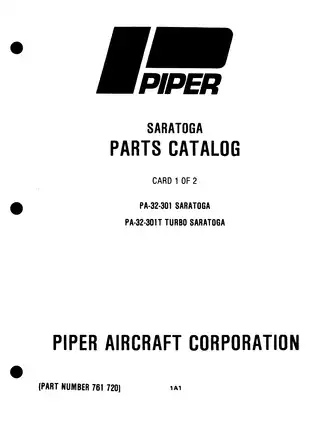
Sample pages from the Parts Catalog: Piper PA-32-301 Saratoga & PA-32-301T Turbo Saratoga (1980-1985) manual

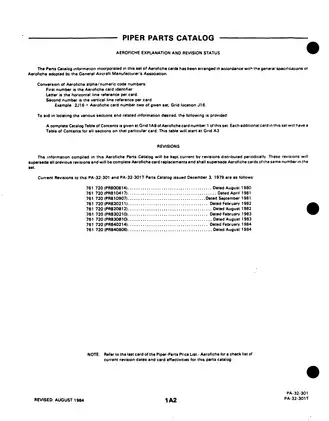
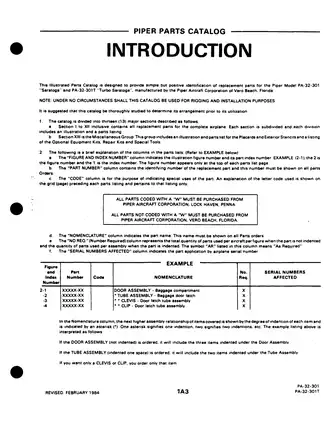
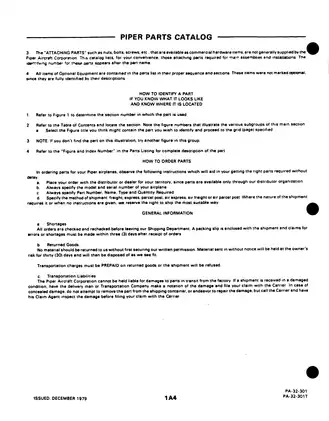
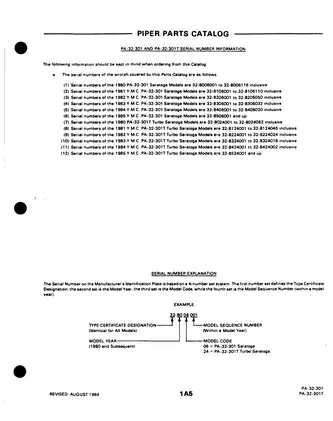
Purchase Information
Piper PA-32-301 Saratoga Parts Catalog for Aircraft Maintenance - Technical Specifications
- Document Number / Seller:
- 25171 / Lisa Gonzalez
- File Size:
- 13.64 MB
- File Type:
- Language:
- English
- Printable:
- Yes
- Estimated Download Time:
- 0.28 Minutes
- Delivery Format:
- Digital (PDF) - Instant Access
- Category:
- Aircraft
- Brand:
- Piper
- Reviewed and Approved:
- Mar 6, 2025
Piper Models and Parts Covered in this Aircraft Manual
- PA-32-301 Saratoga
- PA-32-301T Turbo Saratoga
- PA-32-301 Saratoga (1980-1985)
Complete Manual Information
Piper PA-32-301 Saratoga Parts Catalog
Discover the ultimate parts catalog for the Piper PA-32-301 Saratoga and PA-32-301T Turbo Saratoga, carefully curated to assist both aircraft owners and maintenance personnel in efficiently locating and identifying replacement parts. This digital manual is a must-have resource for ensuring the longevity and performance of your aircraft.
Key Features:
- Detailed Sections: This catalog provides thorough details on all components, aiding users to effectively navigate and find required parts.
- Complete Listing: Included are parts for sections such as the wing, fuselage, landing gear, powerplant, and systems groups. Each section is meticulously outlined with figures, part numbers, and descriptions, making part identification straightforward.
- Up-to-Date Revisions: Established on the latest information to ensure accuracy, facilitating seamless reference for maintenance and repairs.
- Visual Aids: Illustrated diagrams accompany major sections, offering visual clarification for easier understanding of component arrangements.
- Autopilot Systems: Special sections addressing autopilot integration make this a comprehensive tool for aircraft operation.
What's Inside:
- Table of Contents:
- Introduction to the Piper PA-32-301 Series
- Fuselage Group: Wings, Landing gear, Tail surfaces
- Cabin Equipment and Gear: Seating arrangements, Interior components
- Electrical Systems: Wiring, controls, and accessories
- Miscellaneous Parts: Special tools, optional equipment, and more
- Extensive index for quick part number reference
This catalog not only serves as an invaluable tool for mechanics and technicians but also provides aircraft owners with insights on each part’s functionality and ordering information. Access essential, time-saving maintenance solutions today!
Download Instructions for Piper Aircraft Manual
Frequently Asked Questions - Piper Aircraft Manual
What does this Piper manual cover?
This comprehensive service manual covers detailed repair procedures, maintenance schedules, troubleshooting guides, and technical specifications for Parts Catalog: Piper PA-32-301 Saratoga & PA-32-301T Turbo Saratoga (1980-1985). It includes information for the following models: - PA-32-301 Saratoga - PA-32-301T Turbo Saratoga - PA-32-301 Saratoga (1980-1985).
Is this manual suitable for beginners?
Yes, this Piper manual is designed for both professional technicians and DIY enthusiasts. It includes step-by-step procedures with clear illustrations and safety guidelines for Aircraft maintenance and repair.
What file format will I receive?
You will receive this manual as a PDF file (13.64 MB), which is compatible with all devices. The manual is fully searchable and printable for your convenience.
How quickly can I access the manual after purchase?
You'll receive instant access to your Piper Aircraft manual immediately after payment completion. The download link is valid for 3 days, with lifetime re-download guarantee.
Can I print specific sections of the manual?
Absolutely! This digital manual allows you to print any section you need, from individual pages to complete chapters, making it perfect for workshop use.
Customer Reviews and Feedback
Read what our customers say about this Piper Aircraft manual and share your own experience.
Add Comment
This policy contains information about your privacy. By posting, you are declaring that you understand this policy:
- Your name, rating, website address, town, country, state and comment will be publicly displayed if entered.
- Aside from the data entered into these form fields, other stored data about your comment will include:
- Your IP address (not displayed)
- The time/date of your submission (displayed)
- Your email address will not be shared. It is collected for only two reasons:
- Administrative purposes, should a need to contact you arise.
- To inform you of new comments, should you subscribe to receive notifications.
- A cookie may be set on your computer. This is used to remember your inputs. It will expire by itself.
This policy is subject to change at any time and without notice.
These terms and conditions contain rules about posting comments. By submitting a comment, you are declaring that you agree with these rules:
- Although the administrator will attempt to moderate comments, it is impossible for every comment to have been moderated at any given time.
- You acknowledge that all comments express the views and opinions of the original author and not those of the administrator.
- You agree not to post any material which is knowingly false, obscene, hateful, threatening, harassing or invasive of a person's privacy.
- The administrator has the right to edit, move or remove any comment for any reason and without notice.
Failure to comply with these rules may result in being banned from submitting further comments.
These terms and conditions are subject to change at any time and without notice.
Comments (5)